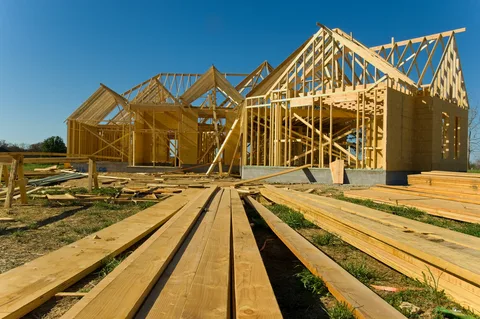The major question that comes to mind when you are starting to work on a home is: how do you estimate lumber cost? Wood is a very vital construction material, and misjudging the cost of this material can break or close your budget. Correct estimation keeps your projects on course and does not leave you with any unwanted surprises in the future.
Although most homeowners like to get an estimate by general figures, it is always better to be informed and estimate. When it comes to such details as selecting the materials and getting the information about the conditions on the site, everything matters. Once you understand a clear lumber cost and calculate, you may project lumber costs more easily.
1. Begin with Detailed House Plans
Before calculations, you require detailed design drawings. These blueprints should cover the sizes of the rooms, roof style, and height of the ceiling. The size and style of the structure determine the quantity of wood. You will also have to consider:
- Exterior and interior walls
- Roofing frames and rafters
- Floor joists and subfloors
- Decking or porches
The more details that you have in your plan, the better your lumber estimate will be.
2. Separate the Framing Parts
To correctly estimate lumber cost, you have to determine different framing components individually. These normally consist of:
- Wall studs
- Plates (top and bottom)
- Headers
- Beams
- Roof trusses or rafters
- Floor joists
Note down the list of components together with the number of them needed. Include waste and damage (10 percent mark). This provides you with a firm foundation in order to start quoting items.
3. Consider the Type and Grade of Lumber
Diversity of lumber types applies to different construction elements. The exterior could require pressure-treated wood, but the inside studs can be regular softwood. Better grades of wood are costly, although they are needed in structural places. Here are a few examples:
- SPF (Spruce-Pine-Fir): budget-friendly, used for framing
- Douglas Fir: stronger and straighter, great for structural support
- Pressure-treated: best for areas exposed to moisture or insects
This is done by selecting the right lumber to be used in every task so as to guarantee safety and conformity to building codes.
4. Use A Lumber Takeoff Sheet
At the center of your checklist is a lumber takeoff sheet. It splits all wood into pieces required for the construction. This document will prevent you to underestimate or buy something unnecessary. Your house plans must be used to make takeoffs, which are to be vetted. Together with a local price list, they can enable you to estimate the lumber cost very well.
5. Include the Existing Market Prices
The prices of lumber vary with time and trend. Your budget can be badly affected by supply chain problems, demand surges, or a shortage in a region. Whenever you are in the market, obtain prices from local suppliers or use online real-time data. Note that it is important to update the lumber cost estimation sheet regularly when your project is running late. Even several weeks matter in terms of changes in prices.
6. Don’t Forget Anchors and Odds and Ends
Your lumber tally cannot be ended without involving costs of nails, screws and nails, brackets and adhesive. These form critical elements of the framing. To estimate lumber cost, you must include:
- Delivery charges
- Taxes
- Storage or on-site protection
All these small things count. They should not be ignored, as this will lead to a budget shortfall.
7. Consider the Construction Wastes
Not all the wood is usable. There are possibilities of wrong cutting boards, warping, or splitting. Industry practice suggests that you should estimate an allowance of 10 percent on top of your estimate to allow for waste. This margin may be increased to 12-15 percent when it comes to a complex or custom build. It is always wise to have an over-quantity rather than to bear the expensive delays.
8. Fill in Estimation Software or Calculators
It is now possible to estimate the cost of lumber using better tools. Calculators on the internet require properties like square footage, the height of the wall, and the style of roof. They then produce volumes of materials. Digital software is more vivid and suitable for a contractor or builder. There are tools to which you can send blueprints, and you get a full takeoff sheet (with amounts and prices).
9. Hire a Professional for help
Sometimes, it would be better to leave it to the specialists. Accuracy and peace of mind are offered by professionals who offer cost estimating services in lumber. They take into consideration what you might not. SMA Estimating LLC should be your go-to choice. Their professionals are aware of how to calculate all costs to save your money and time. The team offers you the best lumber cost estimating services. They let you correct errors, whether you are constructing a home or even when managing a project of client.
10. Peruse Construction Takeoff Services
And once you are not merely dealing with lumber, construction takeoff services will give a detailed breakdown of all others. They are also necessary for comprehensive project planning. These services are based on your blueprints and provide write-ups on:
- Framing
- Roofing
- Plumbing
- Electrical
- Flooring
They make your whole construction plan very simple and control your finances.
11. Get Residential Estimating and Takeoff Assistance
Residential estimating and takeoff services provide takeoff services to home build projects. They know the number of materials required by a typical house. Additionally, they comprise cost variables according to each region. You are also able to get complete packs, such as the cost of labor, taxes, the cost of hiring equipment, and schedules. This degree of detail comes in handy when seeking permits or loans.
Benefits of Using Lumber Estimating Services
Working with a lumber estimation firm brings many advantages:
- High accuracy in quantity and pricing
- Saves time on manual calculations
- Prevents over-ordering and under-buying
- Reduces on-site waste
- Streamlines budgeting
These services will be particularly helpful in bigger or more complex houses. A service can put some money in your pocket, but it can also save lots of cash.
Conclusion
You must be taking a step-by-step process to estimate the lumber cost of a house. Everything counts in your overall expenditure, such as blueprints to pricing. You may as well do it manually or with the help of tools and services. However, the path you choose, it is important to be precise. Working with the professionals is a way out, in case you are serious about your money saving and stress reduction. A cost estimation company may help a lot. You will be less prone to making slip-ups, late completion, and budget overruns. The word planning today can save the regrets tomorrow.









